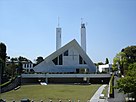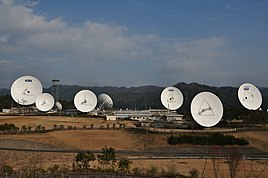Yamaguchi (山口市, Yamaguchi-shi) is the capital city of Yamaguchi Prefecture, Japan. As of 1 July 2023[update], the city had an estimated population of 191,470 in 88,799 households and a population density of 190 persons per km2.[1] The total area of the city is 1,023.23 square kilometres (395.07 sq mi).
Yamaguchi
山口市 | |
|---|---|
Yamaguchi Xavier Memorial Church Yamaguchi Prefectural Government Museum Rurikō-ji five-story pagoda View of Yamaguchi Yamaguchi Satellite Earth Station | |
 Interactive map outlining Yamaguchi | |
 Location of Yamaguchi in Yamaguchi Prefecture | |
| Coordinates: 34°10′41″N 131°28′26″E / 34.17806°N 131.47389°E | |
| Country | Japan |
| Region | Chūgoku (San'yō) |
| Prefecture | Yamaguchi |
| Government | |
| • Mayor | Kazuki Ito |
| Area | |
• Total | 1,023.23 km2 (395.07 sq mi) |
| Population (July 1, 2023) | |
• Total | 191,470 |
| • Density | 190/km2 (480/sq mi) |
| Time zone | UTC+09:00 (JST) |
| City hall address | 2-1 Kameyama-cho, Yamaguchi-shi, Yamaguchi-ken 753-8650 |
| Climate | Cfa |
| Website | Official website |
| Symbols | |
| Flower | Rapeseed flowers, Sakura |
| Tree | Ginkgo |


Geography
editYamaguchi City is located almost in the center of Yamaguchi Prefecture. The city area, which is the largest in the prefecture, is long from north to south, facing the Seto Inland Sea (Yamaguchi Bay) at the south end, and bordering Shimane Prefecture at the north end. The Fushino River runs through the center of the Yamaguchi Basin from north to south, and urban areas are formed on both sides of the river.
Neighbouring municipalities
editShimane Prefecture
Yamaguchi Prefecture
Climate
editYamaguchi has a humid subtropical climate (Köppen climate classification Cfa) with hot summers and cool winters. Precipitation is significant throughout the year, but is much higher in summer than in winter.
| Climate data for Yamaguchi (1991−2020 normals, extremes 1966−present) | |||||||||||||
|---|---|---|---|---|---|---|---|---|---|---|---|---|---|
| Month | Jan | Feb | Mar | Apr | May | Jun | Jul | Aug | Sep | Oct | Nov | Dec | Year |
| Record high °C (°F) | 19.5 (67.1) |
22.5 (72.5) |
24.8 (76.6) |
30.1 (86.2) |
33.8 (92.8) |
34.7 (94.5) |
38.8 (101.8) |
38.8 (101.8) |
36.4 (97.5) |
31.7 (89.1) |
28.1 (82.6) |
23.3 (73.9) |
38.8 (101.8) |
| Mean daily maximum °C (°F) | 9.4 (48.9) |
11.1 (52.0) |
15.0 (59.0) |
20.1 (68.2) |
24.9 (76.8) |
27.8 (82.0) |
31.3 (88.3) |
32.7 (90.9) |
28.9 (84.0) |
23.7 (74.7) |
17.6 (63.7) |
11.6 (52.9) |
21.2 (70.2) |
| Daily mean °C (°F) | 4.4 (39.9) |
5.5 (41.9) |
9.0 (48.2) |
13.9 (57.0) |
19.0 (66.2) |
22.6 (72.7) |
26.4 (79.5) |
27.4 (81.3) |
23.5 (74.3) |
17.7 (63.9) |
11.9 (53.4) |
6.4 (43.5) |
15.6 (60.1) |
| Mean daily minimum °C (°F) | 0.4 (32.7) |
0.8 (33.4) |
3.6 (38.5) |
8.1 (46.6) |
13.3 (55.9) |
18.4 (65.1) |
22.7 (72.9) |
23.4 (74.1) |
19.4 (66.9) |
12.9 (55.2) |
7.0 (44.6) |
2.0 (35.6) |
11.0 (51.8) |
| Record low °C (°F) | −7.6 (18.3) |
−8.9 (16.0) |
−7.6 (18.3) |
−1.2 (29.8) |
3.2 (37.8) |
8.0 (46.4) |
13.1 (55.6) |
14.9 (58.8) |
7.4 (45.3) |
1.3 (34.3) |
−2.5 (27.5) |
−5.5 (22.1) |
−8.9 (16.0) |
| Average precipitation mm (inches) | 76.3 (3.00) |
85.0 (3.35) |
145.6 (5.73) |
168.1 (6.62) |
197.2 (7.76) |
282.9 (11.14) |
342.6 (13.49) |
205.8 (8.10) |
179.1 (7.05) |
91.3 (3.59) |
83.5 (3.29) |
70.5 (2.78) |
1,927.7 (75.89) |
| Average snowfall cm (inches) | 11 (4.3) |
9 (3.5) |
2 (0.8) |
0 (0) |
0 (0) |
0 (0) |
0 (0) |
0 (0) |
0 (0) |
0 (0) |
0 (0) |
3 (1.2) |
26 (10) |
| Average precipitation days (≥ 0.5 mm) | 12.2 | 11.5 | 12.4 | 10.6 | 10.1 | 12.8 | 12.3 | 10.7 | 10.2 | 7.5 | 8.9 | 11.4 | 130.7 |
| Average relative humidity (%) | 76 | 71 | 70 | 69 | 67 | 75 | 78 | 75 | 74 | 73 | 76 | 78 | 74 |
| Mean monthly sunshine hours | 117.9 | 121.3 | 157.4 | 183.9 | 204.3 | 142.3 | 156.2 | 196.2 | 151.7 | 169.4 | 144.0 | 117.6 | 1,862 |
| Source: Japan Meteorological Agency[2] | |||||||||||||
| Climate data for Tokusa, Yamaguchi (1991−2020 normals, extremes 1977−present) | |||||||||||||
|---|---|---|---|---|---|---|---|---|---|---|---|---|---|
| Month | Jan | Feb | Mar | Apr | May | Jun | Jul | Aug | Sep | Oct | Nov | Dec | Year |
| Record high °C (°F) | 16.8 (62.2) |
20.1 (68.2) |
22.9 (73.2) |
28.9 (84.0) |
32.2 (90.0) |
32.7 (90.9) |
36.1 (97.0) |
36.4 (97.5) |
35.1 (95.2) |
30.7 (87.3) |
25.5 (77.9) |
21.8 (71.2) |
36.4 (97.5) |
| Mean daily maximum °C (°F) | 6.4 (43.5) |
7.9 (46.2) |
12.2 (54.0) |
18.1 (64.6) |
23.0 (73.4) |
25.7 (78.3) |
29.1 (84.4) |
30.4 (86.7) |
26.3 (79.3) |
21.0 (69.8) |
15.2 (59.4) |
9.0 (48.2) |
18.7 (65.6) |
| Daily mean °C (°F) | 1.8 (35.2) |
2.8 (37.0) |
6.3 (43.3) |
11.7 (53.1) |
16.8 (62.2) |
20.5 (68.9) |
24.4 (75.9) |
25.1 (77.2) |
20.9 (69.6) |
14.8 (58.6) |
9.2 (48.6) |
3.9 (39.0) |
13.2 (55.7) |
| Mean daily minimum °C (°F) | −2.1 (28.2) |
−1.9 (28.6) |
0.8 (33.4) |
5.6 (42.1) |
11.0 (51.8) |
16.3 (61.3) |
20.8 (69.4) |
21.2 (70.2) |
16.7 (62.1) |
9.6 (49.3) |
3.9 (39.0) |
−0.4 (31.3) |
8.5 (47.2) |
| Record low °C (°F) | −12.4 (9.7) |
−16.0 (3.2) |
−9.5 (14.9) |
−4.1 (24.6) |
0.7 (33.3) |
4.6 (40.3) |
12.2 (54.0) |
13.1 (55.6) |
3.9 (39.0) |
−1.5 (29.3) |
−4.4 (24.1) |
−10.4 (13.3) |
−16.0 (3.2) |
| Average precipitation mm (inches) | 121.9 (4.80) |
106.3 (4.19) |
146.7 (5.78) |
136.6 (5.38) |
153.7 (6.05) |
229.5 (9.04) |
337.8 (13.30) |
201.5 (7.93) |
208.6 (8.21) |
116.7 (4.59) |
97.4 (3.83) |
116.3 (4.58) |
1,973 (77.68) |
| Average precipitation days (≥ 1.0 mm) | 15.8 | 13.5 | 13.7 | 11.0 | 10.0 | 12.6 | 13.1 | 10.9 | 11.6 | 9.2 | 10.7 | 14.1 | 146.2 |
| Mean monthly sunshine hours | 66.5 | 86.6 | 133.7 | 172.5 | 193.0 | 127.0 | 136.0 | 171.3 | 129.6 | 150.5 | 112.3 | 74.8 | 1,553.5 |
| Source: Japan Meteorological Agency[3][4] | |||||||||||||
Demographics
editPer Japanese census data, the population of Yamaguchi in 2020 is 193,966 people.[5] Yamaguchi has been conducting censuses since 1960.
| Year | Pop. | ±% |
|---|---|---|
| 1960 | 172,116 | — |
| 1965 | 162,219 | −5.8% |
| 1970 | 160,347 | −1.2% |
| 1975 | 164,470 | +2.6% |
| 1980 | 173,590 | +5.5% |
| 1985 | 183,149 | +5.5% |
| 1990 | 187,793 | +2.5% |
| 1995 | 193,172 | +2.9% |
| 2000 | 197,115 | +2.0% |
| 2005 | 199,297 | +1.1% |
| 2010 | 196,643 | −1.3% |
| 2015 | 197,422 | +0.4% |
| 2020 | 193,966 | −1.8% |
| Yamaguchi population statistics[5] | ||
History
editThe area of Yamaguchi was part of the ancient Suō Province. During the Muromachi period it was ruled by the Ōuchi clan, who at their height ruled over six provinces in the Chugoku region of western Japan. The Ōuchi clan claimed descent from the royal house of Baekje and grew wealthy due to extensive trade with Korea and Ming Dynasty China. After the Onin War, they welcomed intellectuals who escaped from Kyoto, such that Yamaguchi prospered as a center of culture. Later in the Muromachi period, Christian missionaries from Spain and Portugal were welcomed, and the area became an early center for the Kirishitan faith. The Ōuchi were eventually overthrown by their vassals, the Mōri clan, who ruled the area as part of Chōshū Domain during the Edo Period.
Following the Meiji Restoration, the town of Yamaguchi was established within Yoshiki District, Yamaguchi with the creation of the modern municipalities system on April 1, 1889. On April 1, 1905 Yamaguchi annexed the village of Kami-unorei, followed by Shimo-unorei on July 1, 1915. On April 10, 1929: The town of Yamaguchi absorbed the village of Yoshiki to create the city of Yamaguchi. Yamaguchi annexed the village of Miyano on April 1, 1941. On April 1, 1944, Yamaguchi annexed towns of Ogōri and Ajisu, and the villages of Hirakawa, Ōtoshi, Sue, Natajima, Aiofutajima, Kagawa and Sayama (all from Yoshiki District.)
The town of Ajisu separated from Yamaguchi on November 23, 1947, followed by the town of Ogōri on November 1, 1949. Yamaguchi annexed the town of Ōuchi on May 1, 1963 and the village of Suzenji on November 3, 1963. On October 1, 2005 Yamaguchi merged with town of Tokuji (from Saba District), and the towns of Aio, Ajisu and Ogōri (all from Yoshiki District);. Yoshiki District was dissolved as a result of this merger. On January 16, 2010 Yamaguchi absorbed the town of Atō (from Abu District).
Government
editYamaguchi has a mayor-council form of government with a directly elected mayor and a unicameral city council of 35 members. Yamaguchi contributes six members to the Yamaguchi Prefectural Assembly. In terms of national politics, the city is divided between the Yamaguchi 1st district and the Yamaguchi 3rd district in lower house of the Diet of Japan.
Economy
editAlthough Yamaguchi City is the prefectural capital, excluding public facilities and public works, the other major industries are commerce and the tourism and distribution industries. Despite having the second largest population in the prefecture after Shimonoseki, which is a constituent city of the Kanmon metropolitan area, and the third largest gross city product in the prefecture after Shūnan and Shimonoseki, the city has a very small industrial base.
Education
editColleges and universities
edit- Yamaguchi College of Arts
- Yamaguchi Gakugei College
- Yamaguchi Prefectural University
- Yamaguchi University
Primary and secondary education
editYamaguchi has 32 public elementary schools, 17 public junior high schools operated by the city government, and six public high schools operated by the Yamaguchi Prefectural Board of Education. There is also one national elementary school, one national junior high school and three private high schools. The prefecture operates one special education school for the handicapped and there are two private special education schools.
Transportation
editRailway
editJR West (JR West) - San'yō Shinkansen
JR West (JR West) - San'yō Main Line
JR West (JR West) - Yamaguchi Line
- Shin-Yamaguchi - Suō-Shimogō - Kamigō - Nihozu - Ōtoshi - Yabara - Yudaonsen - Yamaguchi - Kami-Yamaguchi - Miyano - Niho - Shinome - Chōmonkyō - Watarigawa - Mitani - Nagusa - Jifuku - Nabekura - Tokusa - Funahirayama
- Shin-Yamaguchi - Kami-Kagawa - Fukamizo - Suō-Sayama - Iwakura - Ajisu
Highways
editMedia
editNewspaper
editTV
editTwin towns – sister cities
editLocal attractions
edit- Chūya Nakahara Memorial Museum
- Jōei-ji, Buddhist temple with a garden that is a National Historic Site and National Place of Scenic Beauty
- Kōnomine Castle - A castle ruin, one of the Continued Top 100 Japanese Castles.[7]
- Ōuchi-shi Yakata - A castle ruin, one of the Continued Top 100 Japanese Castles
- Rurikō-ji, Buddhist temple with a national treasure five-story pagoda
- Yamaguchi Prefectural Museum of Art
- Yamaguchi Xavier Memorial Church
- Yuda Onsen
Notable people from Yamaguchi City
edit- Yoshisuke Aikawa, founder of Nissan
- Daiki Kamikawa, Olympic gold medalist judoka
- Inoue Kaoru, politician, entrepreneur
- Terauchi Masatake, Prime Minister of Japan
- Chuya Nakahara, poet
- Kishi Nobusuke, Prime Minister of Japan
- Shohei Ono, Olympic gold medalist judoka
- Raizō Tanaka, admiral in the Imperial Japanese Navy
References
edit- ^ "Yamaguchi City official statistics" (in Japanese). Japan.
- ^ 気象庁 / 平年値(年・月ごとの値). Japan Meteorological Agency. Retrieved May 19, 2021.
- ^ 気象庁 / 平年値(年・月ごとの値). JMA. Retrieved May 26, 2022.
- ^ 観測史上1~10位の値(年間を通じての値). JMA. Retrieved May 26, 2022.
- ^ a b Yamaguchi population statistics
- ^ "国際交流". city.yamaguchi.lg.jp (in Japanese). Yamaguchi. Retrieved 2020-04-08.
- ^ "続日本100名城" (in Japanese). 日本城郭協会. 29 November 2017. Retrieved 25 July 2019.
External links
edit- Media related to Yamaguchi, Yamaguchi at Wikimedia Commons
- Geographic data related to Yamaguchi (city) at OpenStreetMap
- Yamaguchi City official website (in Japanese)







